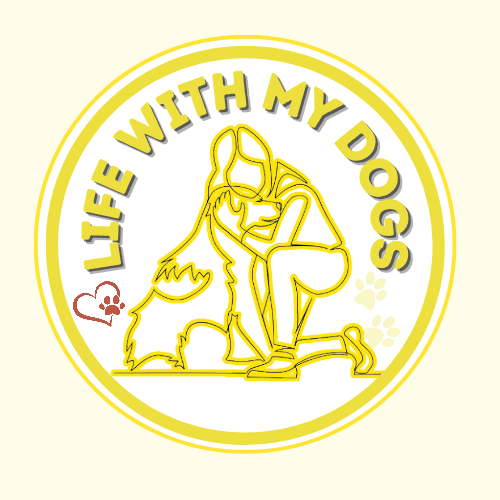LifeWithMyDogs is supported by our audience. When you purchase through one of our links, we may earn a small affiliate commission. As an Amazon Associate I earn from qualifying purchases. Your cost is not affected.
**********
Training multiple dogs has been one of the most rewarding challenges I’ve taken on, and I’m excited to share my Multi-dog training tips with you. Over time, I’ve learned that each dog has its personality, energy, and quirks, which makes balancing their needs a unique experience. Whether you’re managing a lively pack or welcoming a new pup into the mix, I’ve found that the key to harmony lies in consistent training, clear communication, and understanding each dog’s individual needs.
Through trial and error, I’ve developed simple strategies that have helped my dogs work together as a team. From setting boundaries to addressing occasional spats, these tips have transformed my home into a peaceful, tail-wagging haven. I’m excited to share what I’ve learned so you can create a harmonious, happy pack!
Mastering Pack Management – Simple Strategies for Harmony
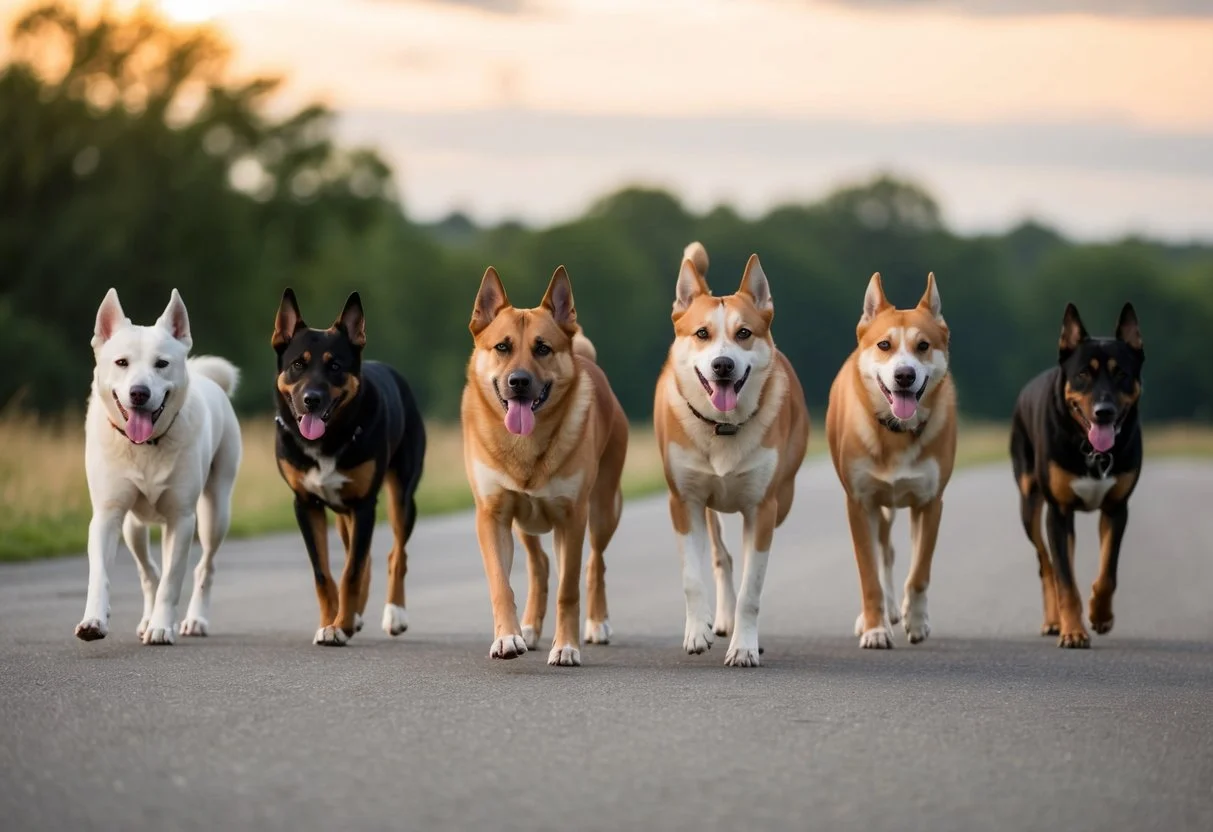
Living with multiple dogs can be a fun and rewarding experience. It’s like having your own furry family! But it can also be tricky to keep everyone happy and well-behaved. That’s where multi-dog training tips come in. Using the right methods, you can create a peaceful home where all your dogs get along and follow the rules.
I’ve learned a lot about managing a pack of dogs over the years. It’s not just about teaching them tricks – it’s about understanding how dogs think and work together. When you get that part right, everything else falls into place.
I’ll share my best tips for training multiple dogs in this post. We’ll look at how to set up a good routine, handle different personalities, and keep everyone safe and happy. Whether you’re new to having several dogs or just looking to improve things at home, these ideas can help make life with your pack much easier.

Key Takeaways
-
Establishing clear leadership helps create a calm, structured home for multiple dogs.
-
Using positive training methods can improve behavior and strengthen bonds within the pack.
-
Consistent rules and routines are key to managing a harmonious multi-dog household.
Understanding Pack Dynamics
Dogs are social animals with complex group behaviors. They use body language and vocalizations to communicate and establish roles within their pack. Let’s explore how these dynamics work and how we can use them to create harmony in a multi-dog household.

The Role of the Alpha
In a dog pack, the alpha is the leader who guides and protects the group. As a dog owner, I’ve learned I must take on this role in my household. I set rules, provide food, and make decisions for the pack. This helps my dogs feel secure and reduces conflict.
I use positive reinforcement to establish my leadership. I reward good behavior with treats and praise. I also control resources like food, toys, and attention. This shows my dogs that I’m in charge. It’s important to be consistent. I enforce rules fairly for all dogs. This prevents confusion and maintains order in the pack.
Recognizing Social Cues
Dogs use many signals to communicate with each other. My dogs use tail positions, ear movements, and body postures to express their feelings and intentions. A wagging tail doesn’t always mean a happy dog. A high, stiff wag can signal aggression. A low, slow wag often means uncertainty.
I watch for these cues to understand how my dogs are interacting. Eye contact is another key signal. Direct staring can be a challenge while looking away shows submission. I teach my dogs to make brief eye contact with me as a sign of respect and attention.
Recognizing stress signals is crucial. Yawning, lip licking, and shaking off can indicate a dog is uncomfortable. I intervene if I see these signs to prevent conflicts from escalating.
Building a Balanced Hierarchy
A stable pack has a clear order. Each dog knows its place, which reduces fights over resources or status. I help my dogs establish this hierarchy through structured interactions. I feed my more dominant dogs first. This respects their position while preventing food aggression.
During playtime, I ensure each dog gets attention, but I don’t force interactions between dogs that don’t get along. Training sessions are a great way to reinforce the pack structure. I work with each dog individually, then bring them together for group exercises.
This builds their confidence and strengthens their bonds with me and each other. I provide separate spaces for each dog. This gives them a chance to relax away from the pack when needed. It’s especially important for more submissive dogs who might need breaks from social pressure.
Crafting Your Training Strategy

Training multiple dogs takes careful planning and a tailored approach. I’ve found that following effective multi-dog training tips and using a mix of methods works best to keep all pups engaged and learning.
Consistency is Key
I always start by setting clear rules for my pack. It’s vital to stick to these rules every day. This helps my dogs understand what I expect from them. I use the same commands and hand signals for each dog. This avoids confusion.
I make sure everyone in my household follows the same rules, too. If one person lets a dog jump up, but another doesn’t, it sends mixed signals. Consistent training creates a stable environment for my pack.
I also keep training sessions short and regular. About 10-15 minutes a few times a day works well. This keeps my dogs interested and prevents them from getting tired or bored.
Individual vs. Group Sessions
I mix up individual and group training for the best results. One-on-one sessions let me focus on each dog’s needs. I can work on specific skills or behaviors without distractions. Group activities are great for teaching social skills. I use these sessions to simultaneously practice commands like “sit” or “stay” with all my dogs.
This helps them learn to listen even when other dogs are around. I always watch for signs of stress or competition during group training. If I notice any issues, I return to individual sessions for a while.
Positive Reinforcement Techniques
I’ve found that positive reinforcement works wonders in multi-dog households. I use treats, praise, and toys to reward good behavior. This makes training fun for my dogs and strengthens our bond. I tailor rewards to each dog’s preferences. Some of my pups love treats, while others prefer a good belly rub. Using the right reward keeps them motivated.
I also use clicker training. The click marks the exact moment my dog does something right. This helps them understand which behavior earned the reward. Remember, patience is key. I celebrate small wins and keep sessions upbeat. This positive approach helps all my dogs learn and grow together.
Communicating with Your Dogs
Good communication is key to managing multiple dogs, and it all starts with effective multi-dog training tips. I’ve found that clear commands, body language, and voice control are essential for a well-behaved pack.

Establishing Clear Commands
I always start with basic commands like sit, stay, and come. I teach a “place” command for multi-dog homes to send each dog to their spot. This helps prevent chaos at the door or during meals. I use hand signals along with verbal cues. This doubles the ways my dogs can understand me.
Consistency is crucial. I make sure everyone in the household uses the same commands and gestures. This avoids confusing the dogs. I practice commands with each dog individually before trying group sessions. This builds a strong foundation.
The Importance of Body Language
Dogs are masters at reading body language. I use this to my advantage when managing a multi-dog household. I stand tall and confident to show leadership. Leaning forward slightly can increase a dog’s focus on me.
I avoid crossing my arms or putting my hands on my hips, which can seem confrontational. Eye contact is powerful. I use it to get attention, but I don’t stare too long, as this can be threatening. I’ve learned to watch my dogs’ body language too. Raised hackles, whale eyes, or a tucked tail can signal tension in the pack.
Voice Control and Tone
My voice is a powerful tool for pack leadership. I use a firm, confident tone for commands and a higher, excited pitch for praise. I keep my voice calm during tense situations. Yelling can escalate excitement or aggression among the dogs.
I use each dog’s name before a command to get their attention. This is especially helpful in a multi-dog setting. I’ve found that a quiet, low voice can be more effective than shouting. It often makes dogs lean in to listen.
I practice different tones for different situations. A sharp “ah-ah” works well as a correction, while a soft “good dog” is perfect for gentle praise.
Multi-Dog Training Tips: Behavioral Correction
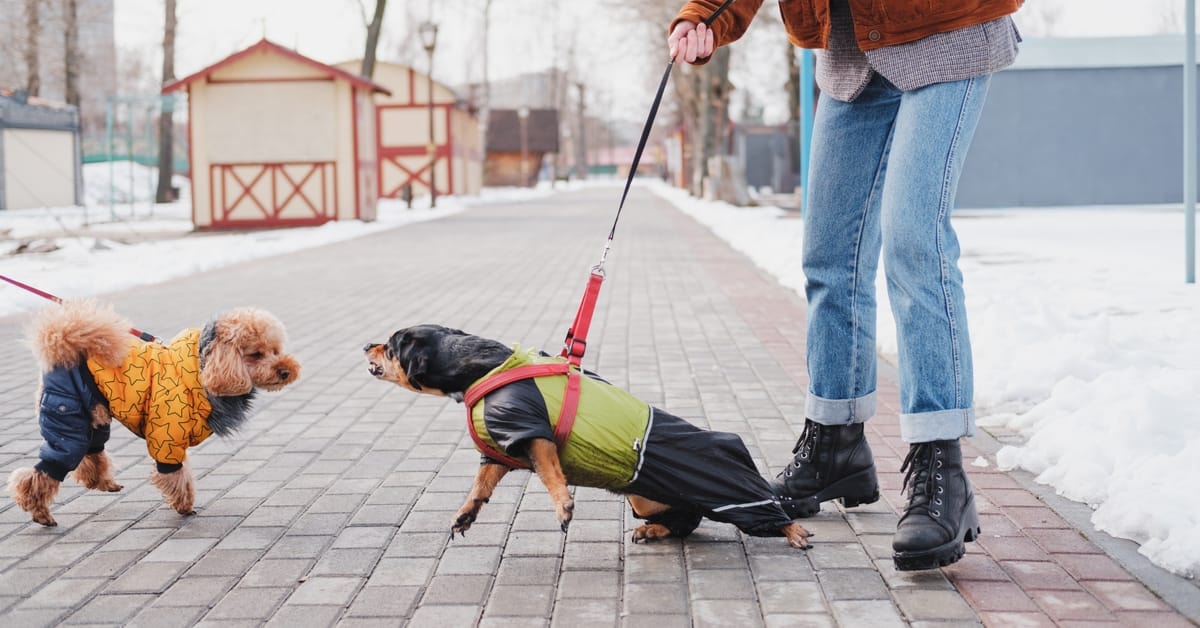
Training multiple dogs requires consistent correction of unwanted behaviors. I’ve found that addressing issues early prevents them from becoming ingrained habits. Let’s look at some key areas to focus on.
Addressing Aggression
When dealing with aggression in a multi-dog household, I always start by identifying the triggers. Is it food, toys, or attention from humans? Once I know the cause, I can work on desensitization. I use positive reinforcement to reward calm behavior around trigger items. For example, I’ll have the dogs sit calmly near each other while I hold a toy.
They get treats to stay relaxed. If fights break out, I separate the dogs immediately. I never punish, as this can increase anxiety and aggression. Instead, I provide clear leadership to reduce tension in the pack. Consistency is key. I make sure all family members follow the same rules and training methods.
Managing Anxiety and Fear
Anxious or fearful dogs can upset the balance in a multi-dog home. I’ve found that building confidence through training helps immensely. I start with simple commands the dog knows well. Lots of praise and treats build a positive association with training. Gradually, I increase the difficulty as the dog’s confidence grows.
For fear of specific triggers, like loud noises, I use counter-conditioning. I pair the scary thing with something good, like treats or play. I never force a fearful dog into scary situations. This can make fear worse. Instead, I let them approach at their own pace. Creating safe spaces for each dog is crucial. Crates or quiet rooms give anxious dogs a place to decompress.
Preventing Resource Guarding
Resource guarding can cause serious fights in multi-dog homes. I tackle this issue early to prevent escalation. I teach “leave it” and “drop it” commands to all dogs. This helps me manage potentially guarded items safely.
Trading games are great for preventing guarding. I offer a high-value treat in exchange for a toy or food item. This teaches dogs that giving up resources leads to good things. I feed dogs separately to avoid food-related conflicts. Each dog gets their own space to eat without feeling threatened. When introducing new toys or chews, I supervise closely. I praise calm sharing and redirect any signs of guarding.
Training Exercises for Packs
Training multiple dogs together can be challenging but rewarding. These multi-dog training tips will help you manage your pack effectively and create a harmonious household.

Synchronized Obedience Drills
I find that synchronized obedience drills are great for keeping all dogs focused. I start with basic commands like “sit” and “stay” for the whole group. I make sure to reward each dog individually for good behavior. This helps prevent competition and jealousy among the pack.
For more advanced drills, I practice “down-stay” with distractions. I’ll walk around the dogs or bounce a ball nearby. This teaches them to stay calm and obedient even when exciting things happen.
I also like “leave it” exercises with treats on the floor. This builds impulse control and respect for boundaries in a group setting.
Recall Challenges
Recall training is crucial for pack management. I start by calling one dog at a time from a short distance. As they improve, I increase the difficulty. I use a special whistle or word for group recalls. This teaches all dogs to come running when called, no matter what they’re doing.
To make it fun, I turn recall into a game. I’ll hide treats around the yard and call the dogs to “find it.” This reinforces coming when called and builds excitement for the command. I practice recalls with distractions like toys or food for a real challenge. This helps ensure my dogs will listen even in tempting situations.
Group Walks and Heel Work
Group walks are a great way to reinforce pack order and obedience. I start by walking each dog individually to establish good habits. I use a “no-pull” harness for each dog when walking as a group. This gives me better control and prevents tangling leashes.
I practice “heel” with all dogs at once. I reward them for staying in position and not getting distracted by each other or their surroundings. I’ll have the dogs walk in different formations to mix things up. Sometimes in a line, sometimes side-by-side. This keeps them focused and responsive to my cues.
Socialization and Play
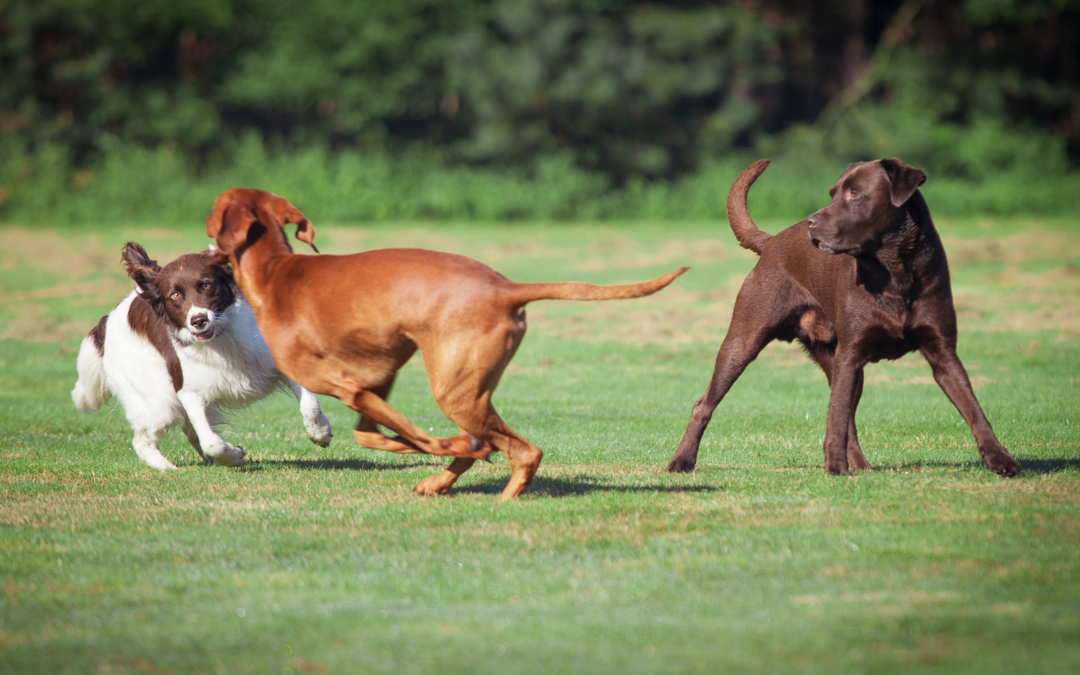
Socializing dogs and providing structured play opportunities are key to effective multi-dog training tips. These activities help build bonds and prevent conflicts between pack members.
Integrating New Members
When I bring a new dog into my pack, I take it slow. I start with short, supervised meetings in a neutral space. This helps avoid territorial issues. I watch for signs of stress or aggression and step in if needed.
I make sure each dog gets individual attention. This prevents jealousy. I also give treats when they’re calm around each other. It creates positive associations.
Over time, I increase the length of their interactions. I always monitor their body language closely. If things go well, I let them play together under my watchful eye.
Organized Play Dates
I set up regular play dates for my dogs. This gives them a chance to burn energy and practice social skills. I choose playmates carefully, matching dogs with similar energy levels and play styles.
I keep play sessions short at first, about 15-20 minutes. This prevents overexcitement. I always supervise and step in if play gets too rough.
I use toys to encourage positive interactions. Tug toys can be fun, but I set rules to prevent fights. I end play sessions on a positive note, with calm praise and treats for good behavior.
Controlled Environments for Social Growth
I create safe spaces for my dogs to interact with others. I use baby gates at home to give each dog a retreat if needed. This helps prevent fights and reduces stress. For outdoor socialization, I start in quiet areas. I gradually expose them to busier places as they gain confidence.
I always keep them on a leash in new environments. I use positive reinforcement to reward calm behavior around other dogs and people. This builds their social skills and confidence. I never force interactions if a dog seems uncomfortable.
Multi-Dog Training Tips: Health and Wellness Management
Caring for multiple dogs means paying attention to their diet, exercise, and medical needs. I’ve learned that each dog is unique, so I tailor my approach to keep them healthy and happy.
Diet and Nutrition for Multiple Dogs
I always ensure each dog gets the right food for their needs. Bigger dogs need more calories, while smaller ones need less. I use separate bowls for each dog to avoid fights over food.
Some of my dogs have special diets. My older Lab needs joint-friendly food, while my young Border Collie gets high-energy kibble. I track what each dog eats with a chart on my fridge.
Treats are important, too! I use small, healthy snacks for training. This way, I can reward good behavior without overfeeding. I always have fresh water available in several spots around the house.
Exercise Routines for Different Breeds
I’ve found that each dog needs a different amount of exercise. My Border Collie loves long runs, but my Bulldog prefers shorter walks. I try to give each dog the right amount of activity:
-
High-energy Breeds: 1-2 hours of intense play or running daily.
-
Medium-energy Breeds: 30-60 minutes of moderate exercise.
-
Low-energy Breeds: 15-30 minutes of gentle walking.
I mix up our activities to keep things fun. We do fetch, agility courses, and swimming. On busy days, I also use puzzle toys to give mental exercise.
Regular Vet Check-Ups
I take all my dogs for check-ups at least once a year. Puppies and seniors go more often. I keep a calendar to track each dog’s appointments. During visits, I make sure each dog gets:
-
Vaccinations.
-
Parasite checks.
-
Dental exams.
-
Weight checks.
I always bring a list of questions about each dog’s health. This helps me catch any issues early. I also keep their medical records in a binder at home. Regular check-ups help me stay on top of flea and tick prevention. I set reminders on my phone for monthly treatments.

Positive Training: Happy Dog, Happy You
Stubborn dogs need extra patience and creativity. I’ve found that using positive reinforcement works wonders. Treats, praise, and toys can motivate even the most stubborn pup.
Advanced Training Techniques
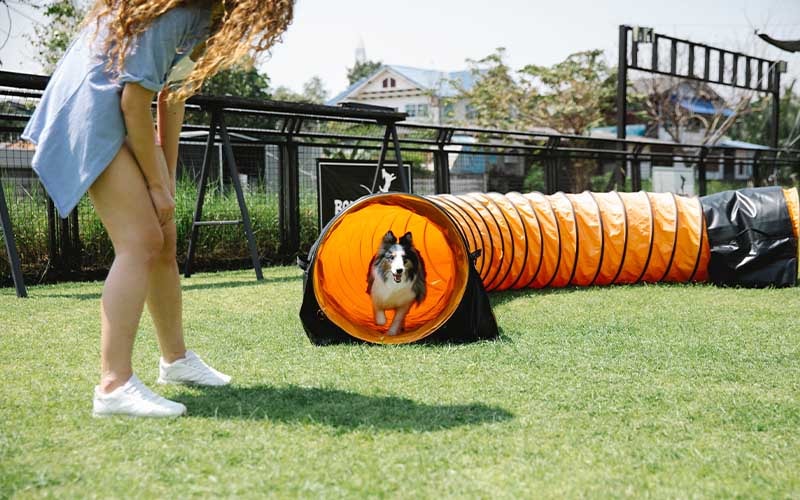
Training multiple dogs requires special skills and methods, and that’s where multi-dog training tips come in. I’ve found great ways to challenge and engage a pack of pups. These techniques help build teamwork and keep everyone’s mind and body active.
Agility Training for the Pack
I love using agility training with my multi-dog household. It’s a fun way to burn energy and build confidence. I set up simple obstacle courses in the backyard using everyday items. Jumps made from broomsticks and chairs work well. Tunnels from cardboard boxes are another easy option.
I teach each dog the course separately at first. Then, I gradually bring them together. I make sure to praise good behavior and teamwork. Seeing the dogs learn to take turns and cheer each other on is amazing.
Agility also helps with impulse control. Dogs must wait their turn and stay focused. This skill carries over to daily life, making the pack easier to manage.
Cognitive Games for Mental Stimulation
Mental exercise is just as important as physical activity for dogs. I use puzzle toys and games to keep my pack’s minds sharp. One favorite is the “cup game,” where I hide treats under cups and let the dogs find them.
I also play “find it” games. I hide toys or treats around the house and let the dogs search. This taps into their natural scenting abilities. It’s fun to watch them work together to solve the puzzle.
Another great game is teaching dogs to put their toys in a basket. This combines obedience with problem-solving. Plus, it helps keep the house tidy!
Custom Training for Specific Needs
Every dog in a pack has unique needs. I tailor training to address individual issues. For example, I focus on desensitization exercises if one dog is reactive to strangers. This helps the whole pack stay calm during walks.
I also work on each dog’s weak spots. Maybe one needs leash training while another struggles with recall. I set aside time for one-on-one sessions to tackle these issues.
Group training is still important. I teach the pack to respond to commands as a unit. “Stay” and “come” are crucial for safety. I practice these in different settings to ensure reliability.
Here’s an additional video about training multiple dogs.
By: Zak George’s Dog Training Revolution
Building a Harmonious Multi-Dog Household Through Effective Training
Training multiple dogs is a rewarding yet challenging experience, and mastering it requires patience, consistency, and a deep understanding of each dog’s unique personality. You can create a harmonious environment where your dogs thrive by establishing clear leadership, maintaining structured routines, and recognizing pack dynamics. Each dog in the pack brings its quirks and energy, but a balanced approach to leadership fosters cooperation and reduces conflicts.

Effective communication through clear commands and body language plays a pivotal role in multi-dog training. A mix of individual and group sessions allows targeted learning while reinforcing social skills. Positive reinforcement and consistent behavioral correction, helps address common issues like resource guarding or anxiety. Over time, these strategies strengthen the bond between you and your dogs, creating a cohesive and happy pack.
Ultimately, living with multiple dogs fosters mutual respect and understanding within the household. With the right training techniques and a commitment to meeting each dog’s needs, you can enjoy a peaceful, tail-wagging home. Whether you’re starting fresh or fine-tuning your approach, these tips ensure a harmonious and fulfilling life with your furry family.
Frequently Asked Questions
Training multiple dogs can be tricky. I’ve gathered some common questions to help you manage your pack better. These tips cover attention, resource guarding, commands, hierarchy, mealtimes, and new dog introductions.
How Can I Ensure Each Dog Gets Individual Attention During Training Sessions?
I recommend setting aside one-on-one time with each dog daily. Even 5-10 minutes of focused training can make a big difference. I also like to rotate which dog I work with first during group sessions to keep things fair.
What Are Some Effective Strategies for Preventing Resource Guarding in a Multi-dog Household?
To prevent resource guarding, I ensure plenty of toys, beds, and food bowls for everyone. I also teach my dogs to “leave it” and “wait” for treats or toys. Rewarding calm behavior around resources helps too
What Techniques Work Best for Reinforcing Commands When Training Multiple Dogs at Once?
I use a “one at a time” approach when training multiple dogs. I give a command to one dog, reward them, then move to the next. I also practice group stays and recalls to reinforce listening skills in distracting situations.
Join the Pack: Unleash the Doggo Fun!
Tired of the same old dog content? Join the Life With My Dogs community for a fresh take on all things furry.
Discover:
- Learn how to train multiple dogs like a pro, inspired by our in-depth guide.
- Find the best gear for your furry friends, backed by real-world experience.
- Connect with like-minded pet parents and share your adorable pup pics.
Follow us on:
- Facebook: Life With My Dogs
- Instagram: @LifeWithMyDogs2
- Pinterest: Life With My Dogs
- YouTube: Life With My Dogs
